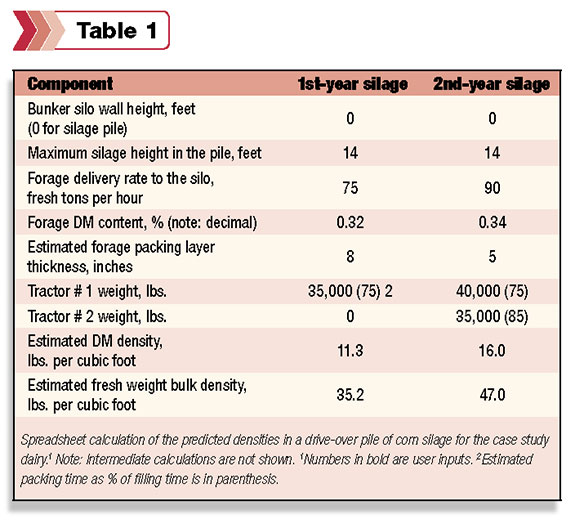A survey of dairy producers in Pennsylvania showed that only a quarter of the 147 bunkers or piles sampled had a silage density of at least 14 pounds dry matter (DM) per cubic foot.
The recommended packing density is 15 to 16 pounds of DM and 44 to 48 pounds of fresh weight per cubic foot. Anything less than these densities will result in a significant financial loss through a higher shrink and lower nutritional value.
There are substantial monetary gains to be had if packing densities can be improved. To illustrate this point, let me share the following case study.
A herd that I work with was having some production issues related to their corn silage program. Ration DM intake was down by four to six pounds per cow per day from the previous year, and milk production per cow per day was down significantly from the previous year.
An evaluation of their drive-over pile of corn silage showed that the density was only 11.4 pounds of DM per cubic foot (using the core sample technique).
The silage was very unstable at feedout, and there was a lot of visible surface spoilage. I estimated that the “shrink loss” for the corn silage pile was going to be between 20 and 25 percent.
The first step toward improving the corn silage program was to sit down as a team. The meeting included the owners, the silage contractor, the nutritionist, the feed company representative, the banker and myself.
The density of the corn silage very quickly surfaced as the number one problem – over the objection of the brother who had always operated the blade/pack tractor. He insisted that he did not need any help and that a second tractor would “just get in his way.”
The Holmes-Muck spreadsheet from the University of Wisconsin Extension, which calculates a predicted silage density, was applied to the dairy’s current corn silage.
 The predicted density was very close to the actual – 11.3 pounds versus 11.4 pounds of DM per cubic foot (see Table 1).
The predicted density was very close to the actual – 11.3 pounds versus 11.4 pounds of DM per cubic foot (see Table 1).
Then the spreadsheet was used to determine what needed to be done to achieve a packing density of at least 15 pounds of DM per cubic foot.
The dairy made the following silage management changes the second year:
The forage delivery rate increased from 75 to 90 tons per hour. The average whole-plant DM content increased from 32 to 34 percent.
A second tractor was added to assist in packing, and 5,000 pounds of weight was added to the blade/pack tractor.
(Note: The silage contractor had a higher-capacity forage harvester, which was equipped with a kernel processor.)
These changes resulted in a predicted corn silage DM density of 16 pounds per cubic foot.
The actual density averaged 16.4 pounds of DM per cubic foot. Silage density and shrink loss are inversely related – increasing the density from 11.4 to 16.4 pounds of DM per cubic foot decreased the shrink loss by 5 to 7 percentage points from the first year to the second.
What were the economics of the higher density? There was 3,500 tons of corn silage in the pile with a value of $60 per ton. Reducing the shrink loss from 20 percent to 14 percent saved 210 tons of silage with a total value of $12,600.
The cost of adding the second pack tractor was $5,250 ($1.50 per ton), so the dairy had a net saving of $7,350 of corn silage.
Remember, the goal is a silage density of 15 to 16 pounds of DM and 44 to 48 pounds of fresh weight per cubic foot. The University of Wisconsin Extension packing density spreadsheets can be found here.
For more information, email Keith Bolsen.
Twelve key considerations to improve density
1. Good communication is essential. For example, if forage delivery rate increases at any time during the day, you must be prepared to add an extra pack tractor.
2. Employ well-trained, experienced people, especially those who operate the push-up/blade tractors. Provide training as needed.
3. When pushing up, forage should be skimmed from the edge of a dumped load of forage.
4. Forage should be spread in uniform layers of six inches or less.
5. Form a progressive wedge of forage and maintain a maximum slope of one-to-three (one foot of rise for each three feet of horizontal).
6. The slope can be decreased to one-to-four, depending on the forage delivery rate and number of pack tractors.
7. Align the pack tractor tire with the track of the previous tractor pass.
8. There should be at least two pack tractor passes over the surface of each layer of forage.
9. Drive-over piles should be packed from side to side as the progressive wedge advances, and the sides of the pile should never exceed a slope of one-to-three.
10. When two or more pack tractors are used, establish a driving procedure.
11. Whenever possible, drive up and back down packing slopes. Do not drive pack tractors in a circle and avoid making 180-degree turns on the floor of a bunker or front apron of a pile.
12. Finally, reducing the forage delivery rate is rarely an option, as very few producers or silage contractors are inclined to slow the harvest rate. FG










